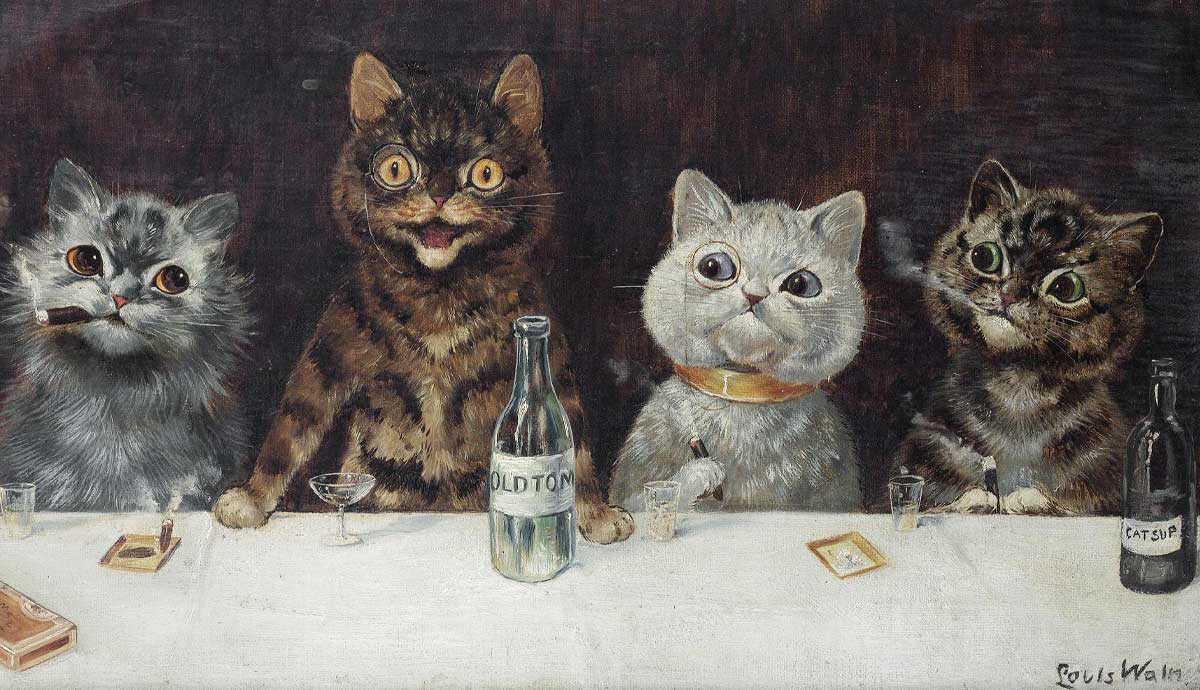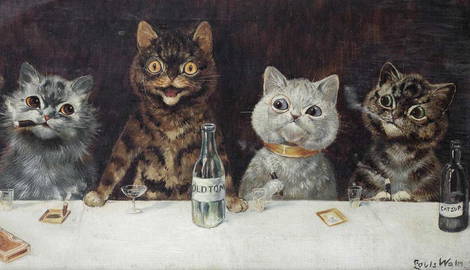
Louis Wain was one of the most prolific artists of the 19th and 20th centuries. With many thousands of pieces to his name, his illustrations graced the pages of journals, newspapers, and annuals. His images were put on postcards and sent around the world, and he even found fame as a ceramic artist. Not only was his art prolific, but he was a beloved character in London society. Through his art, he changed attitudes towards his favorite subject: cats.
Much maligned as unclean and even considered evil by some, cats were present in Victorian times as nothing more than a way to keep the rodent population down. Wain’s love of cats, however, shone through in his work. Not only did he change the perception of cats in Britain, but he made them a beloved part of British culture, bringing fame (and constant work) to himself. Louis Wain’s art is instantly recognizable and is still very much admired and loved today.
Louis Wain’s Early Works

Like all artists, Louis Wain’s art evolved over time and throughout different periods in his life. At school, he had no clear vision of what kind of artist he wanted to be, but all of his ideas revolved around art. After leaving school, he studied at the West London School of Art, where he also had a job as a teacher to provide for his mother and sisters after his father passed.

In 1881, he left home and rented an apartment where he devoted time to his illustrative art, surrounding himself with books of natural history and science through which he could study the images. His first art to be published was on December 10, 1881 in the Illustrated Sporting and Dramatic News. It was a picture of bullfinches. Louis Wain submitted many more illustrations to the journal before the editor decided to provide him with more regular work drawing dog shows, livestock, country houses and estates, and sporting events.
Louis Wain’s art would diversify when he started working for many other publications. However, working for the Illustrated Sporting and Dramatic News added stability to Louis Wain’s income, and he continued to publish illustrations through this journal throughout the 1880s.

Louis Wain’s art, however, is not known for realism nor for the illustrations of real events he drew for the Illustrated Sporting and Dramatic News. Cats became the predominant theme of Louis Wain’s art, and it was in 1884 when his first cat illustration was published in the Illustrated London News. The image is a multi-panel drawing of the different moods of cats and is a more realistic depiction of the animals compared to the anthropomorphic images for which he became famous. The first four panels of the illustration feature his cat, Peter, for which he had an enduring (and endearing) love.
Louis Wain’s Art Becomes Famous

1886 was a special year for Louis Wain’s art. It was then that a picture was published that really catapulted Louis Wain into fame. A Kitten’s Christmas Party, commissioned by Sir William Ingram, the editor of the Illustrated London News, was published in December of 1886. The final product was a multi-paneled illustration that featured almost 200 cats doing various human things at a Christmas party. Louis Wain’s first foray into anthropomorphism was published, and it was very well received, causing a sensation in London society. Sir William Ingram sent the picture to the Victoria and Albert Museum so that it could be displayed to reach a wider audience.

1886 also saw Louis Wain’s art appear in children’s books. Madame Tabby’s Establishment was the first in a long line of children’s books to feature Louis Wain as an illustrator. The book tells the story of a school where kittens are taught manners. Being one of the first Londoners to raise a kitten, Louis Wain was perfect for the job.

Sadly, a month after the illustration was published, Louis Wain’s wife, Emily, died of breast cancer. It was one of several tragedies that would have a significant impact on his life, as well as his art. His beloved cat, Peter, stayed by his wife’s side while she was suffering and provided inspiration for Louis Wain’s art. Peter became a muse of sorts, and Wain created many portraits of him, even before his wife had died. She had pushed him to continue drawing cats and to have his cat art published.

Another tragedy in his life was the death of Peter. In 1898, at the age of 15, Peter passed away. Peter was Louis’ link to his late wife, and this death affected Louis, furthering his descent into sadness (and madness). Nevertheless, Louis Wain’s art still showed images of happy cats doing human things. They often existed as satire, poking fun at the eccentricities of the rules and regulations of Victorian social life.
Foray into Ceramics

In 1914, Louis Wain’s art took an interesting turn as the artist began experimenting with ceramics. He produced a series of ceramic animals for a London retailer. Although most animals were cats, he also made sculptures of dogs, pigs, and many other animals. Their design showed influence from the Cubist movement and artists like Pablo Picasso. Although popular, they did not grab the attention of the British public the same way his illustrations and paintings had. They did, instead, find a market in the United States. Sadly, and perhaps typical of Louis Wain’s financial misfortunes, the boat transporting them to America was sunk by a German U-boat. The surviving pieces are rare and very valuable, with some fetching £10,000 ($11,500). Each item was sold with a little slip of paper with a unique motto.
Louis Wain’s Later Life & Psychedelic Period

Louis Wain’s art evolved as the artist’s psychological state evolved. It has never been confirmed, but it is highly likely that Louis Wain had schizophrenia. His sister was declared insane with similar symptoms, so there may have been a genetic tendency in his family. His erratic behavior caused him to be admitted to a pauper’s asylum, as his family of sisters was too poor to afford anything else.
Wain had been financially unlucky during his life and had omitted to copywrite a lot of his work. This made his sisters resent him, as it was his responsibility to provide for them financially. According to one theory, Louis Wain’s art shows his suffering during this time as his work became more abstract and detached from reality. This theory would be sound if all his artworks were dated, but much of his work isn’t, and it is difficult to present Louis Wain’s art in definitive chronological order.
Nevertheless, Louis Wain’s art at this time was colorful, psychedelic, and kaleidoscopic. Decades later, his art was marveled at by psychedelic artists who commented that it was truly amazing how Louis Wain was able to create such art without the influence of LSD.

After a year in terrible conditions, the British public discovered his predicament, and petitioned to have him relocated to a more pleasant hospital. With the support of H.G. Wells and the personal intervention of Prime Minister Stanley Baldwin, Louis Wain was saved from his awful situation. He would get a final upgrade in 1930 to a hospital with a cat colony, which no doubt brightened his outlook so that his final years were a lot more serene than the years that came before. He would decorate his room with colorful imagery and positive messages that wished people happiness. Every Christmas, he was tasked with brightening up the establishment, and his drawings on all the mirrors became an annual occurrence that was much anticipated.
The Legacy of Louis Wain’s Art

Louis Wain’s art forms an extensive corpus of works across multiple media. Apart from his ceramic sculptures, he created many thousands of illustrations and paintings during his lifetime. His art fell out of fashion during World War II and the subsequent years of Britain rebuilding its shattered economy, but a renewed interest in the late 1960s saw his work become immensely famous. There have been many exhibitions in various museums around Britain, and many artists have drawn inspiration from his works.
Louis Wain’s art was, and remains, a happy interrogation of mischief and fun. His illustrations and paintings exude love and, in turn, are still loved by their many admirers who recognize the innocent quality of his playful imagery.










